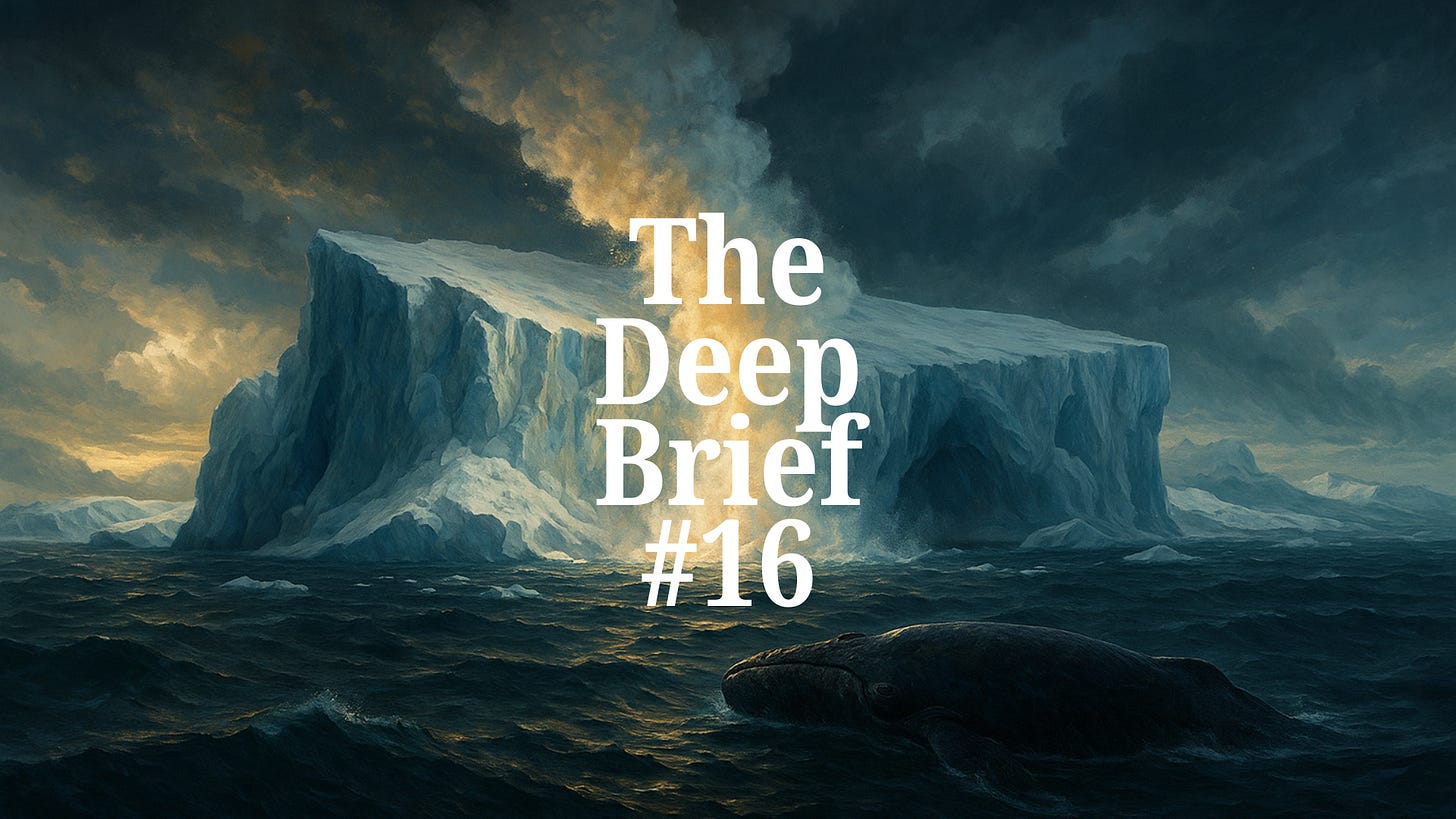The Deep Brief #16 | 11 October 2025
Your end-of-week ocean intelligence, built to inform, agitate and equip you
Scientists found methane escaping from beneath Antarctic ice this week. Not leaking. Escaping. The kind of discovery that changes what we thought we knew about planetary boundaries.
You won’t find this story leading the news. Yet it’s the kind of signal that separates those who see what’s coming from those who are surprised when it arrives.
Welcome to your essential ocean intelligence.
Deep Dive #1: Southern right whales are running out of fuel
New research from Argentina’s Península Valdés shows southern right whales are producing 30–40% fewer calves compared to two decades ago. The reason? Their food is disappearing.
These whales need dense blooms of copepods and krill to build the fat reserves required for migration and pregnancy. Climate-driven shifts in the Southern Ocean are collapsing that energy base. When a 50-ton whale can’t find enough food to reproduce, it’s a signal that entire ocean food webs are unravelling.
The health of whales is a mirror. Right now, it’s showing us something we can’t ignore.
Deep Dive #2: Antarctica is releasing methane, and we’re just finding out
Scientists have discovered active methane seeps beneath Antarctica’s ice shelves. These aren’t small leak, they’re plumes of gas that’s 80 times more potent than CO₂ as a greenhouse gas over a 20-year period.
This methane was locked in frozen sediments for millennia. Now it’s mobile. Researchers are racing to determine how much reaches the atmosphere versus being consumed by microbes, but the discovery confirms a terrifying feedback loop: warming unlocks more greenhouse gases, which causes more warming.
Antarctica isn’t just responding to climate change anymore. It’s amplifying it.
Deep Dive #3: Robot fleets are mapping the ocean’s hidden climate engine
The UK Met Office is deploying autonomous ocean robots to depths humans can’t easily reach, monitoring heat, salinity, and carbon in near real time across vast stretches of open ocean.
The ocean has absorbed 90% of the excess heat from global warming, but we’ve had almost no visibility into where that heat is stored or how it’s moving. These robots are closing one of the biggest blind spots in climate science, and the data they’re gathering will help us detect tipping points before they cascade.
This is what 21st-century oceanography looks like: machines extending our senses into the deep.
Next week on the podcast: The lead scientist behind the Antarctic methane discovery explains what this means for climate models, and why we’re only finding these seeps now. Paid subscribers get the episode 48 hours early, plus the full transcript and research notes.
Three Stories Worth Your Attention
🌊 Ocean Adventure Photographer of the Year announced. Ben Thouard’s winning images capture the ocean as a living force. Beauty that demands protection. View gallery →
🐢 Green sea turtles saved from the brink. Decades of protection brought them back from near extinction. Proof that conservation works when we commit across generations.
Full story →
🏅 New Ocean Award launched at IUCN Congress. Recognition for bold leadership in marine protection, launched when innovation needs more visibility than ever. Details →
One Hard Truth
The ocean’s fever isn’t breaking
September 2025 was the third-warmest September on record globally. That makes 16 consecutive months of exceptional ocean heat, according to new Copernicus Climate Service data.
This isn’t weather. This is rewriting.
Coral reefs are bleaching across multiple oceans simultaneously. Fish populations are migrating away from traditional fishing grounds. Oxygen levels in seawater are dropping because warm water holds less dissolved gas, and therefore less life.
Marine heatwaves used to be rare events. Now they’re recurring seasons of stress. The ocean’s ability to absorb our excess heat and carbon, the planetary service that has shielded us from far faster warming, is not infinite.
The hard truth: The ocean’s limits are becoming visible. Every tenth of a degree matters. Once critical thresholds are crossed, recovery could take centuries. If it happens at all.
Read the full Copernicus report →
Paid subscribers receive a monthly deep-dive report that goes beyond the headlines.
November’s report: The Economics of Ocean Restoration: who profits when we save the sea, and who pays when we don’t. 5,000+ words. Dozens of sources. Zero ads.
Final Word
The ocean still carries our excess, our heat, our carbon, our mistakes. Yet this week’s evidence shows the strain: whales unable to reproduce, ancient methane escaping ice, machines deployed to measure what we can no longer see.
The question isn’t whether the crisis is real. The evidence is overwhelming.
The question is whether our response will match its scale.
Why People Subscribe
This briefing is free, three deep dives, three quick hits, one hard truth. Every weekend.
People become paid subscribers because they want:
→ Early podcast access: Episodes drop 48 hours early with full transcripts and source lists
→ Access to weekly articles 2 weeks before free subscribers
→ Monthly investigative reports: 5,000+ word deep dives on single topics (plastic treaties, deep-sea mining, fisheries collapse)
→ Direct access: Monthly Q&A sessions where you ask the questions
→ No ads, ever: This stays independent and evidence-based
→ To support ocean journalism: When mainstream media cuts their environment desks, this keeps going
The ocean has no marketing budget. No lobby. No voice in the rooms where decisions are made.
It needs ours.
💙 Become a paid subscriber — £5/month or £50/year
If you’re not ready to subscribe, the single most valuable thing you can do is forward this to someone who cares about the ocean. Growth comes from readers like you.
See you next week.
- Luke



